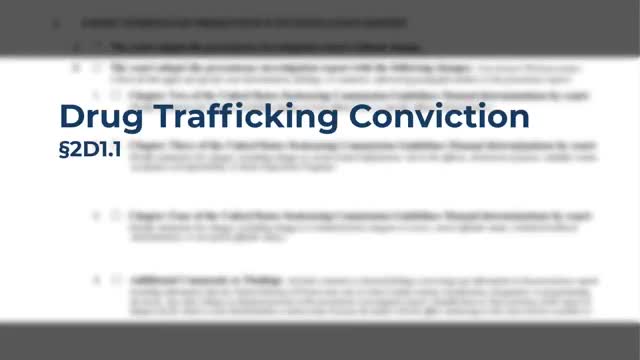Court Adjusts Drug Conviction Guidelines for Methamphetamine Sentencing
October 02, 2025 | United States Sentencing Commission, United States Courts, Judiciary, Federal
This article was created by AI summarizing key points discussed. AI makes mistakes, so for full details and context, please refer to the video of the full meeting. Please report any errors so we can fix them. Report an error »

In a recent government meeting, significant discussions centered around the Statement of Reasons Instruction by United States Courts, particularly regarding the guidelines for drug trafficking convictions. The meeting highlighted the importance of accurately determining drug quantities and the corresponding base offense levels, which directly impact sentencing outcomes.
During the meeting, it was noted that a pre-sentence report initially calculated a base offense level of 22 for a drug trafficking case involving methamphetamine, based on a quantity of 40 to 50 grams. However, the court found that the correct quantity was between 30 and 40 grams, resulting in a revised base offense level of 20. This adjustment underscores the court's role in ensuring that sentencing reflects the actual circumstances of each case.
Additionally, the meeting addressed the evaluation of a defendant's role in criminal activity. While the pre-sentence report suggested a four-level reduction for being a minimal participant, the court determined that a two-level reduction was more appropriate, categorizing the defendant as a minor participant. This decision illustrates the court's discretion in assessing a defendant's involvement and its implications for sentencing.
The meeting also covered the documentation process for mandatory minimum sentences. The court must clearly indicate whether a mandatory minimum penalty applies and whether the imposed sentence meets or exceeds this threshold. This clarity is crucial for maintaining consistency and transparency in sentencing practices.
Furthermore, the discussion included the handling of plea agreements, emphasizing the need for accurate recording of whether agreements are binding or nonbinding, or if no agreement exists at all. This aspect is vital for ensuring that all parties understand the terms and implications of the plea process.
Overall, the meeting reinforced the importance of precise documentation and adherence to guidelines in the sentencing process. These discussions are expected to enhance the fairness and effectiveness of the judicial system, ensuring that sentences are appropriately tailored to the specifics of each case. As these practices are implemented, they will likely lead to more equitable outcomes for defendants and a clearer understanding of sentencing standards within the community.
During the meeting, it was noted that a pre-sentence report initially calculated a base offense level of 22 for a drug trafficking case involving methamphetamine, based on a quantity of 40 to 50 grams. However, the court found that the correct quantity was between 30 and 40 grams, resulting in a revised base offense level of 20. This adjustment underscores the court's role in ensuring that sentencing reflects the actual circumstances of each case.
Additionally, the meeting addressed the evaluation of a defendant's role in criminal activity. While the pre-sentence report suggested a four-level reduction for being a minimal participant, the court determined that a two-level reduction was more appropriate, categorizing the defendant as a minor participant. This decision illustrates the court's discretion in assessing a defendant's involvement and its implications for sentencing.
The meeting also covered the documentation process for mandatory minimum sentences. The court must clearly indicate whether a mandatory minimum penalty applies and whether the imposed sentence meets or exceeds this threshold. This clarity is crucial for maintaining consistency and transparency in sentencing practices.
Furthermore, the discussion included the handling of plea agreements, emphasizing the need for accurate recording of whether agreements are binding or nonbinding, or if no agreement exists at all. This aspect is vital for ensuring that all parties understand the terms and implications of the plea process.
Overall, the meeting reinforced the importance of precise documentation and adherence to guidelines in the sentencing process. These discussions are expected to enhance the fairness and effectiveness of the judicial system, ensuring that sentences are appropriately tailored to the specifics of each case. As these practices are implemented, they will likely lead to more equitable outcomes for defendants and a clearer understanding of sentencing standards within the community.
View full meeting
This article is based on a recent meeting—watch the full video and explore the complete transcript for deeper insights into the discussion.
View full meeting